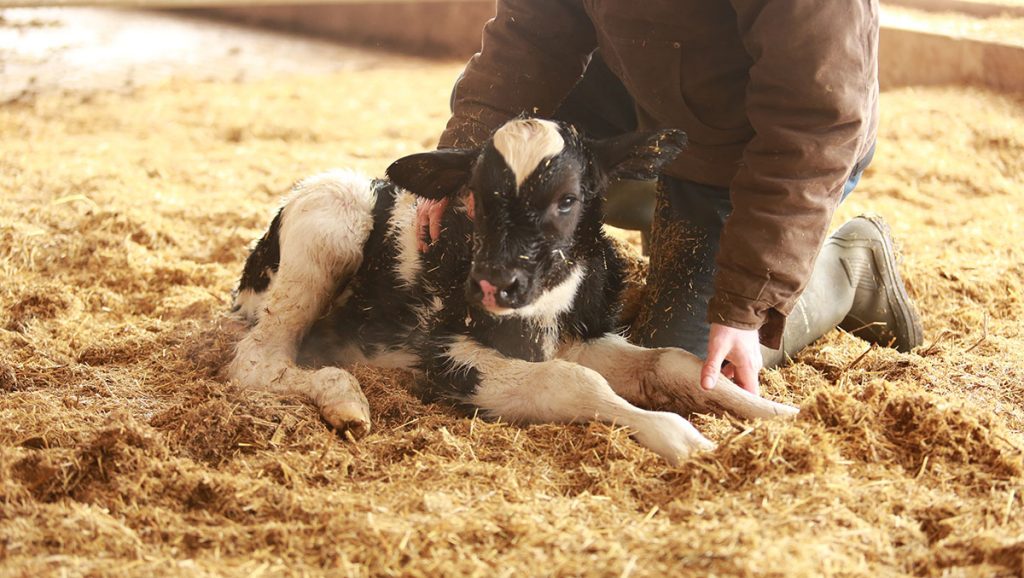Healthy Calf Conference
Follow to stay up-to-date on all Healthy Calf Conference updates. Speaker announcements, sponsorship information, registration announcements, and more.
While calving trouble, or dystocia, is generally accepted as a health challenge for some cows and heifers, many producers do not realize a difficult birth can have negative impacts on the calf as well. Both the dam and calf may need special attention to recover from a difficult birth to get the lactation and growth phases off to a healthy start. Consider the following when making a care protocol for calves after a difficult birth.

If a calf is born non-responsive, you should never swing it, hang it over a gate, or hold it upside down to encourage it to breathe. It is a myth this practice removes fluid from the lungs since any fluid seen coming out of calves in this position is actually from the stomach. Further, holding a calf’s hind end above its lungs places the weight of the gut on the lungs, making it more challenging for it to breathe and fully inflate its lungs.
If a calf needs assistance breathing, place it in the recovery position by rolling the calf into the sternal position where its chest and stomach are on the ground. The front and back legs should all be extended straight forward. This gives both lungs an equal opportunity to expand by reducing the amount of weight on them. Vigorous rubbing can also be used to stimulate a calf ’s breathing. Finally, tickling the inside of a calf’s nose with straw or a small amount of cold water in the ear may stimulate the calf to gasp and take a breath.
If you need to intervene during a calf’s birth or take steps to resuscitate it, be sure to keep an especially close eye on the calf in the first few hours of life since it may have reduced vitality. Vitality is considered as having the capacity to live and grow, which requires energy and strength. Inflammation, pain, injury, lack of oxygen, acidosis and other conditions resulting from dystocia may reduce calf vitality. Any of these conditions can prevent calves from having the strength to perform certain behaviours essential to survival, such as drinking colostrum. Calves unable to consume colostrum cannot develop their immune systems, which are essential to preventing and overcoming disease in the first few weeks of life.
The Visual Appearance, Initiation of Movement, General Responsiveness, Oxygenation, and Rates (VIGOR) scoring system can be used to assess calves at birth and determine their vitality. The system requires 10 measurements that can be taken on farm, without special equipment, in less than two minutes per calf. The system scores the time it takes for the calf to stand or walk, response to straw in the nasal cavity, mucous membrane colour, heart rate and other simple measures.
A higher VIGOR score will mean a less vigorous calf. Calves with a high VIGOR score should be monitored more closely in the first few days of life. Consider making VIGOR scoring part of your routine newborn calf care. Producers often assess these measures in their calves without following a formal chart or recording the results. However, having a standardized scoring and recording system will help you communicate newborn calf health data to other caretakers and your herd veterinarian. Reviewing VIGOR scores along with other health or production data once the calf is older may help you determine why some calves thrive while others do not.
Research suggests providing meloxicam to calves may help them recover from difficult births. Meloxicam is a non-steroidal anti-inflammatory drug that can provide pain relief, and reduce fever and inflammation. When calves assigned a high newborn VIGOR as a result of an assisted calving were given meloxicam, their VIGOR scores and suckling reflexes improved when compared with calves that did not receive the drug after an assisted birth. Calves treated with meloxicam also had greater milk intakes leading to greater average daily gain. Administering meloxicam to calves after dystocia may lead to improved vitality and productivity. Remember to check the labels of all animal health products administered for withdrawal times, record which calves were given treatments, and give this information to the buyer if you sell the calf. Talk to your herd veterinarian about protocols for administering meloxicam to calves that experienced a difficult birth.
“Assessing calf vigour following birth can help producers identify calves that require additional care and reduce (calf death) losses following a difficult calving. By ensuring a calf with poor vigour receives appropriate care, including therapy for pain associated with inflammation or cracked ribs, as well as warmth and nutrition through colostrum, these animals have the potential to achieve the same health and growth performance outcomes as vigorous calves,” Dr. Christine Murray-Kerr advises.
Murray-Kerr is a ruminant nutrition research scientist with Trouw Nutrition. She, along with Dr. Ken Leslie, professor emeritus at the Ontario Veterinary College at the University of Guelph, developed VIGOR scoring and protocols for administering meloxicam to less vigorous calves.
Don’t underestimate the impact of a difficult birth on both the cow and calf; both need individualized attention to help them recover. Ask your herd veterinarian about creating a dystocia protocol for calves, which should include how to resuscitate calves and may include assessing calf VIGOR and administering meloxicam to less vigorous calves. By recognizing the impact of dystocia on calves, dairy producers can take steps to assist calves to get the best start possible, ensuring future health and productivity.
This project was funded in part through Growing Forward 2 (GF2), a federal-provincial-territorial initiative. The Agricultural Adaptation Council assists in the delivery of GF2 in Ontario.
Follow to stay up-to-date on all Healthy Calf Conference updates. Speaker announcements, sponsorship information, registration announcements, and more.
The Codes of Practice are nationally developed guidelines for the care and handling of farm animals. They serve as our national understanding of animal care requirements and recommended practices.